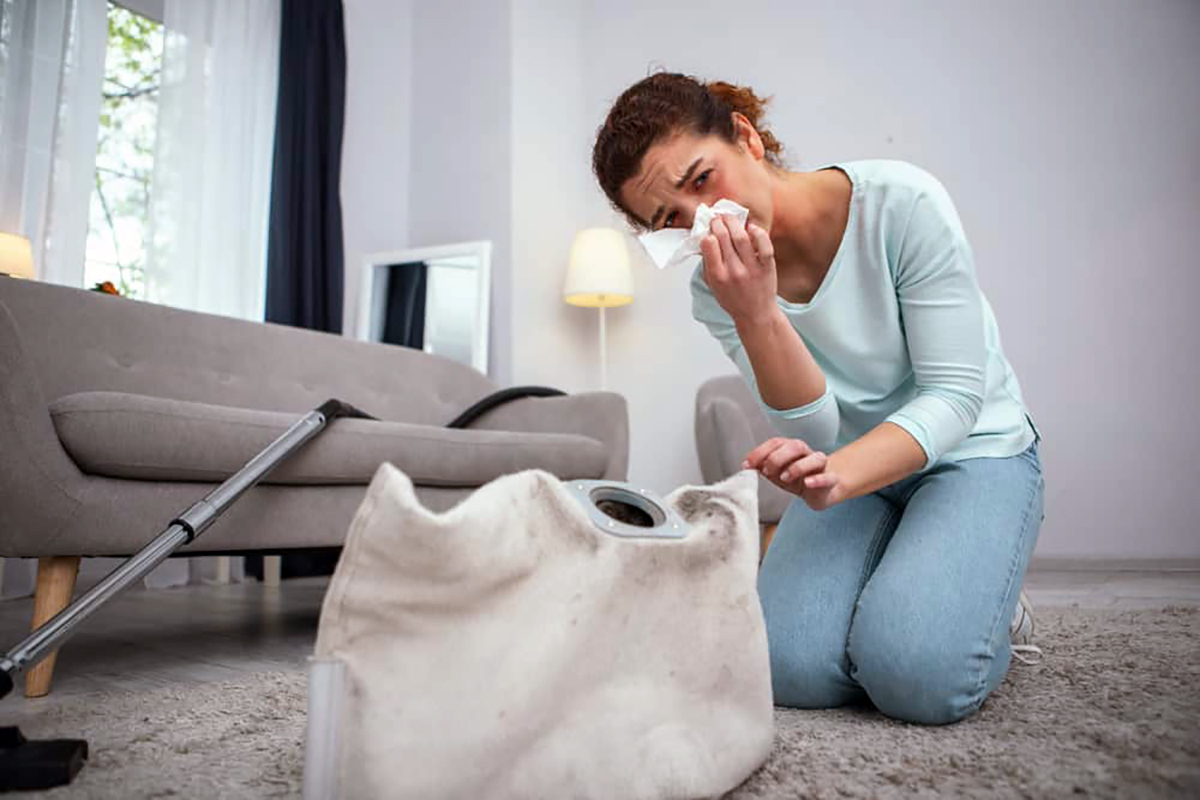Carpeting can make a room feel cozy. But it can also house allergens, which get kicked into the air whenever it’s walked on. This can happen in even in the cleanest house. Pollen and microscopic irritants living in your carpet can come from inside and outside, and can also come in on the bottoms of shoes, or through open windows.
Carpet fiber, padding, and the glue required to hold them together can also cause allergic reactions in some people. If you can’t figure out why your eyes are itchy or your nose won’t stop running when you’re home, your carpet may be to blame.
Symptoms
The common allergens that exist in and around your home will inevitably find their way into your carpet. Just like everything else in our atmosphere, allergens in the air are subject to gravity’s pull. If you have carpet, this results in allergens getting trapped beneath your feet. These include:
- Pet Dander
- Pollen
- Microscopic Insect parts
- Dust
- Dust Mites
- Mold
If you’re allergic or sensitive to any of these substances, allergy-induced asthma, contact dermatitis, or allergic rhinitis can result. Symptoms you may experience include:
- Itchy, watery eyes
- Sneezing
- Itchy, running nose
- Scratchy, irritated throat
- Itchy, red skin
- Coughing
- Hives
- Trouble breathing
- Wheezing
- Feeling pressure in the chest
- Shortness of breath
Allergens & Carpet
Even a carpet that is regularly vacuumed can harbor a large quantity of trapped allergens, in and around fibers. Not all carpets are created equal, however.
High-pile (or long-pile) carpeting, such as shag or frieze rugs, are composed of long, loose fibers. These provide allergens with places to stick, and mold with places to grow.
Low-pile (or short-pile) carpets have a tighter, shorter weave, so allergens have less room to hide. This does not, however, mean that low-pile carpets cannot provide a cozy home for dust, dirt, and pollen.
Allergy associations, such as the American Lung Association and the Allergy and Asthma Foundation of America, suggest avoiding all types of wall-to-wall carpeting in favor of washable throw rugs and hard flooring.
Hard floors, such as laminates, wood, or tiles, do not have nooks and crannies for allergens to become trapped in, so they can be washed away easily.
Despite this, if you have your heart set on carpeting, the AAFA suggests choosing short- over long-pile carpet.
Tips for allergy-proofing
If you’re allergic to the materials your carpet is made of, removing it may be your best, most comfortable option. Our showroom here at Saddleback Carpet & Flooring has the largest selection of flooring products in Orange County! Choosing a hard surface flooring like Vinyl, or hardwood flooring is a great allergy-friendly option. If you are allergic to the irritants hiding in your carpet, allergy-proofing your home may help. Things to try include:
Vacuum at least once a week, with a vacuum that has a high efficiency particulate air (HEPA) filter. HEPA filters remove and trap allergens, so they don’t get recirculated back into the air. Make sure to get a vacuum that is HEPA-certified and not HEPA-like.
If you have a pet, make sure your vacuum is also designed to pick up pet hair.
Reduce the humidity in your home so dust mites and mold cannot proliferate.
Steam clean your carpets several times a year, preferably monthly. Make sure there is enough circulating air to let them dry completely.
Rather than carpeting, opt for throw rugs which can be washed in hot water.
Use the same deep-cleaning techniques for other soft fabrics in your home, including upholstery and drapery.
Keep windows closed during allergy season and on days when pollen levels are high.
Install an air-filtration system, which uses a HEPA filter.
